| | Assessment of the quality of biological control agents | Aphids | Two-spotted spider mite | Thrips | Loopers and caterpillars | Whitefly | Fungus gnats | Lygus bugs | Ear wigs
Descriptions of the common pests of greenhouse peppers are followed with a list of the biocontrol agents recommended for control. Pesticides are not discussed. Pesticide recommendations can be obtained from a greenhouse crop production specialist.
Assessment of the Quality of Biological Control Agents
Biological control agents are living organisms and their ability to establish and control pest populations depends on their fitness. When ordering biological control agents ask the supplier what to look for to help assess the quality of the agents when they arrive. A hand lens or magnifying glass is very useful when inspecting packages of biological control agents. All packages of biological control agents should be inspected on arrival. Packages arriving during the winter should be checked immediately to ensure that they have not been frozen or subjected to cold temperatures. The inside of the shipping cooler should not be cold, if the ice pack contained within the cooler is frozen solid, it is likely that the entire package froze and the biological controls have been damaged or killed (Portree 1996). Packages received during the summer months should be cool inside, if they are hot then the biological control agents may be damaged or killed.
Always release the biological control agents into the greenhouse as soon as possible after they are received. Follow the instructions provided with the package.
Aphids
The green peach aphid (Myzus persicae) is the most common aphid pest of greenhouse sweet peppers but there are other aphid species that can become a problem in greenhouse peppers. These other aphid species include; the melon aphid (Aphis gossypii), the potato aphid (Macrosiphum euphorbiae) and the foxglove aphid (Aulacorthum solani). Not all aphid biological control agents are equally effective on all aphid species so it is necessary to be sure of the identity of the aphid species in question. All of the species eventually develop winged forms.
Green peach aphids are usually light green in color, but can be pinkish or yellowish in color in the fall (Howard et al 1994, Portree 1996). The body is about 1.2 to 2.5 millimeters long and egg shaped. The winged forms can have black or brown colored heads and black markings on the body.
The melon aphid adults are usually either black or green when there are just a few aphids present, but as the population grows and the aphids become crowded the colors can range from olive green to yellowish green. Melon aphids are about the same size as green peach aphids, 1 to 3 millimeters long, they can be distinguished from the other aphid species by the dark black cornicles and short antennae (Howard et al 1994, Portree 1996).
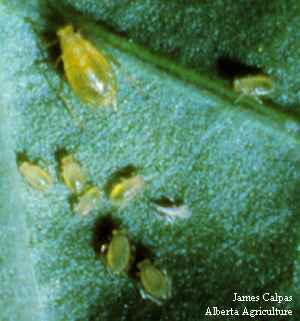
Figure 34. Green peach aphids.
Potato aphids are quite large, 1.7 to 3.6 millimeters long and the body is wedge-shaped and yellowish green to pink in color (Howard et al 1994). The head has prominent antennal tubercles that are directed outwards (Howard et al 1994). Potato aphids will drop off the leaves when disturbed (Howard et al 1994).
Foxglove aphids are smaller than potato aphids but larger than melon and green peach aphids. This aphid is a shiny light yellowish green to dark green in color with a pear-shaped body Howard et al 1994). The only markings on the bodies of wingless adults are darkish patches at the base of the cornicles (Howard et al 1994).
Aphids can be present in the pepper crop very early, even while the plants are just in the seedling stage. They can come in on the transplants as well. Aphids feed by sucking the plant sap. Symptoms of aphid infestation include the development of sticky honeydew on the leaves and fruit. The presence of honeydew on the fruit requires that the fruit be washed prior to going to market. Sooty mold is often associated with the aphid honeydew, this mold uses the honeydew as a food source and grows to resemble a layer of "soot" on the leaves and fruit. The presence of sooty mold on the fruit also makes washing the fruit a necessity. The growing points, young leaves, flowers and young leaves can be damaged and distorted. and in severe infestations flower abortion can occur.
Aphid control should be started in propagation with the introduction of parasitic wasps; Aphidius matricariae for green peach aphid, Aphidius colemani for the melon aphid and green peach aphid and Aphidius ervi for potato aphid. Another parasitic wasp Aphelinus abdominalis is effective against the potato and foxglove aphid.
Parasitized aphids become silvery-brown in color with a small exit hole at the back when the parasite has emerged. The larvae of the midge Aphidoletes aphidimyza feed on most aphid species, but will not feed on gall forming aphids (Don Elliott, pers comm) Aphid hot spots and population explosions may require introductions of lady beetle species, Harmonia axyridis, the Asian lady beetle and large scale introductions of Hippodamia convergens.
Introductions of these predators and parasites may have to continue throughout the entire season. For best results always use a combination of aphid predators and parasites. Consult your local supplier for information and recommendations on release rates.
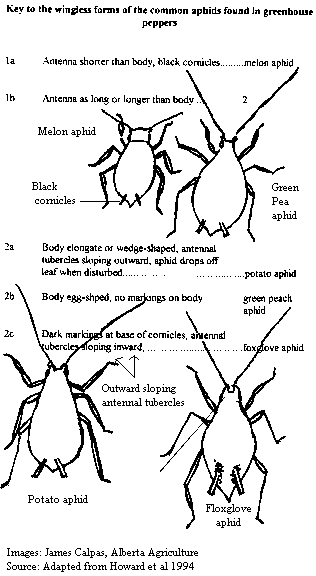
Figure 35. Key to the wingless forms of the common aphids found in greenhouse peppers
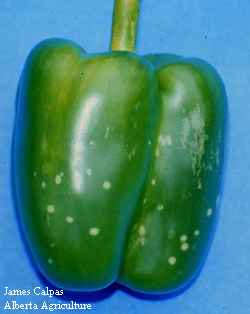
Figure 36. White spots on pepper fruit caused by aphid feeding on the fruit bud when it was still young.
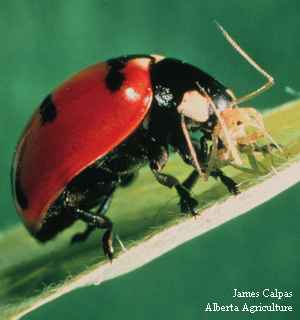
Figure 37. A lady beetle adult consuming an aphid.
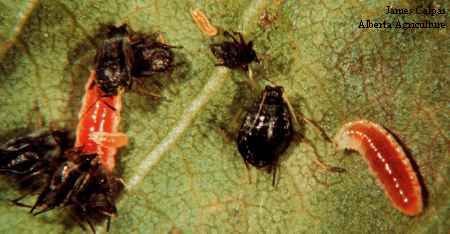
Figure 38. Aphidoletes midge larvae feeding on aphids.
Two-Spotted Spider Mite
The two-spotted spider mite (Tetranychus urticae) is a common pest of a number of greenhouse crops (Howard et al 1994, Portree 1996). Typical symptoms of two-spotted spider mite infestations include speckling of leaves and fine webbing on the underside of affected leaves. As the spider mite population increases, the leaves become brittle and brown in color, the amount of webbing on the leaves becomes very prominent and the mites can be seen milling about on the webs. It is very easy for the two-spotted spider mites to be "picked-up" on clothing and transported throughout the crop by workers. As the season progresses into fall, female two-spotted spider mites develop a bright orange-reddish color as they prepare for the winter. The female mites seek shelter in crevices throughout the greenhouse and a thorough end of season pressure wash clean-up is necessary to minimize the number of females that survive to the next crop.
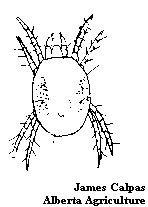
Figure 39. Two-spotted spider mite.
Effective biological control of the two-spotted spider mite is obtained by introducing the predatory mite Phytoseiulus persimilis as soon as two-spotted spider mites are detected in the crop. P. persimilis does well in the pepper canopy, and once established throughout the greenhouse it controls the spider mite population for the remainder of the season. The mites Amblyseius fallacis and Amblyseius callifornicus are closely related to P. persimilis and establish well and gives better control under low density mite situations, but should be used along with P. persimilis (Don Elliot, pers comm).
Thrips
There are two species of thrips that are common pests in greenhouse vegetable crops, the western flower thrips (Franliniella occindentalis), and the onion thrips (Thrips tabaci) (Howard et al 1994, Portree 1996). Thrips feed by opening wounds on the plant surface and sucking out the contents of the plant cells, the feeding results in small whitish streaks on the leaves and fruit and can cause distortions in the young developing fruit (Howard et al 1994, Portree 1996).
The adult thrips congregate in the flowers and regular monitoring of the flowers will allow for the early detection of thrips. Yellow and/or blue sticky traps placed throughout the crop, as with the other insect pests, will help in the early detection of thrips infestations. Avoid using yellow traps if Apidius sp. are being used for the control of aphids in the crop.
In addition to causing direct feeding damage and resultant yield loss, both thrips species are vectors of Tomato Spotted Wilt Virus (TSWV) which can be a serious disease problem in peppers and tomatoes (Howard et al 1994, Portree 1996). One of the main control measures for minimizing the spread and infection of TSWV within the crop is to control the thrips vectors.
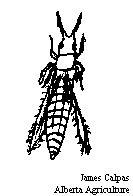
Figure 40. Thrips.
There are a number of predators available for biological control of thrips: predatory mites Amblyseius degenerans, Amblyseius cucumeris, Hypoaspis miles and Hypoaspis aculeifer and predatory bugs, Orius insidiosis and other Orius species.
Loopers and Caterpillars
At least two species of loopers have been associated with problems in greenhouse pepper crops, the cabbage looper, Trichoplusia ni, is the most common, with the alfalfa looper Autographa californica being an occasional problem. The damage is caused by the larval stages which can reach 2.5 to 3.5 centimeters in length depending on the species. The cabbage looper is the larger the two species in the final larval stage. The larva are a light green in color with whitish stripes along the length of their bodies. The larvae feed on foliage and fruit, fruit damage consists of holes in the fruit, accompanied by frass on and around the calyx. As the loopers reach their mature size, the amount of feeding damage can be considerable.
Loopers generally enter the greenhouse through vents and other openings as adult moths which then lay eggs on the plants. The eggs hatch and the larval or looper stages begin feeding and complete their life cycle in about 20 days. As a result, a number of generations can be completed in the crop if control measures are not taken. Loopers overwinter as pupae, and can overwinter inside the greenhouse.
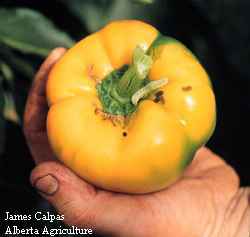
Figure 41. Looper on a pepper fruit.
(Portree 1996). When the greenhouse enters the new production cycle, the moths emerge, mate and begin egg-laying in the new crop (Portree 1996).
Screening intake vents will help prevent adult moths from entering the greenhouse. Pheromone traps can be used to detect the presence of adult moths in and around the greenhouse, and acts as an indicator for when to introduce biocontrol agents. Ultra-violet light traps are also used to catch adult moths. The egg parasite Trichogramma brassicae should be released as soon as adults are detected. The parasite Cotesia magriniventris should also be introduced, this parasite prefers to attack young loopers. Bacillus thuringiensis (B.T.) can also be used as part of the biocontrol program. B.T. is a microbial biocontrol agent which is activated once the loopers consume plant material which has been sprayed with B.T. Also, since the loopers are quite large, they can be removed by hand when they are found in the crop.
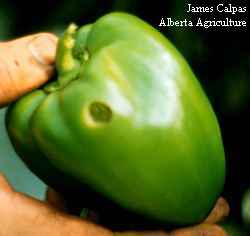
Figure 42. Looper feeding damage on a pepper fruit.
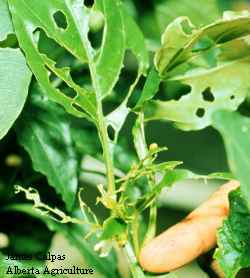
Figure 43. Looper feeding injury on pepper leaves.
Whitefly
The greenhouse whitefly (Trialeurodes vaporariorum) is a common and serious pest in greenhouse crops in Canada (Howard et al 1994). However, it is rarely a problem on greenhouse sweet pepper (Howard et al 1994). A second whitefly species, the sweet potato whitefly, Bemesia tabaci, has been found in some greenhouses in British Columbia (Portree 1996). Of the two whitefly species, the sweet potato whitefly is more difficult to control (Portree 1996).
Greenhouse whitefly adults are about two millimeters long and congregate on the undersides of the leaves. The usually fly short distances when disturbed. The whitefly nymphs are clear, flattened scales about 1.0 millimeter long at their largest size, and are also found on the underside of the leaves. The sweet potato whitefly is smaller than the greenhouse whitefly and is more yellowish in color (Portree 1996).
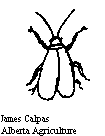
Figure 44. Greenhouse whitefly.
Whitefly damage the plant by sucking sap from the leaves. Large infestations can cause leaf yellowing and a general decline in the plant. Sooty mold is commonly found in association with whitefly. As with aphids, whitefly feeding also results in honeydew formation which can reduce fruit quality. The presence of the honeydew and sooty mold can necessitate that the fruit be washed prior to going to market. The presence of sooty mold on the leaves can reduce the productivity of the leaf by reducing the amount of light reaching the leaf surface (Howard et al 1994).
The parasitic wasps, Encarsia formosa and Eretmocerus eremicus, are effective against whitefly with parasitized whitefly scale becoming yellow or black in color, depending on the parasite. Scale parasitized by Encarsia formosa is black in color. Delphastus pusillus is a small beetle that feeds on whitefly eggs and is ideal for complementing Encarsia and Eretmocerus (Portree 1996).
Fungus Gnats
Fungus gnats are commonly found in practically all greenhouse crops (Howard et al 1994). Fungus gnats are an indicator of moist conditions in the greenhouse and populations generally grow to be quite large early in the year or whenever there is pooling of water on the greenhouse floor. Adult fungus gnats range from 2 to 3 millimeters in length, while the larvae are 4 to 5 millimeters long. The larvae of the fungus gnats are the damaging stage and feed on the roots. They are generally not a problem in greenhouse tomato and pepper, but can be a serious in cucumbers (Howard et al 1994), especially young plants. Affected plants develop slowly and may eventually collapse if too much of the root system has been damaged (Portree 1996). There is evidence that fungus gnat adults may transport root rot fungi such as Pythium sp. and Fusarium sp. from plant to plant, contributing to the spread of disease caused by these fungi (Howard et al 1994). Fungus gnats are often confused with shore flies, as both are common in the greenhouse under wet conditions. Shore flies are slightly larger than fungus gnats, and look like scaled-down versions of house flies, while fungus gnats look more like tiny mosquitos that don't bite.
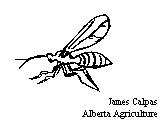
Figure 45. Fungus gnats.
Biological control of fungus gnats is obtained through the use of predatory mites Hypoaspis miles and most recently Hypoaspis aculeifer. Both of these predatory mites also have activity against thrips larvae that move to the base of the plants to pupate. Nematode parasites in the genus Steinernema are applied as a drench to the root zone and kill the fungus gnat larvae by penetrating the larvae and consume them from the inside.
Lygus Bugs
Lygus bugs (Lygus spp.) are common pests of field crops in Alberta, particularly alfalfa and canola, and have become increasingly important in greenhouse vegetable crops (Howard et al 1994, Portree 1996). There are a number of species within the genus which can become pests in the greenhouse including Lygus lineolaris. When nearby alfalfa or canola fields are cut or harvested, large numbers of Lygus bugs can be displaced and move into the greenhouse. Lygus bugs can enter the greenhouse through unscreened vents.
Adult Lygus bugs can reach 5 to 6 mm in length and can range in color from green to brown with mottled black markings. Once in the greenhouse, Lygus bugs can continue their life cycle and establish a population within the greenhouse. Both the adults and nymphs feed on plant juices through piercing and sucking mouthparts. The bugs like to feed on the plants at the growing points and can damage the developing flower bud that in-turn results in malformed fruit.
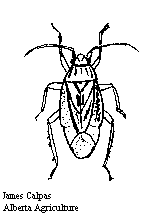
Figure 46. Lygus bug.
Lygus bugs are relatively large, fast-moving insects which can be difficult to control with biologicals. Orius and Deraeocoris will feed on Lygus bugs (Portree 1996). Preventing the entry of Lygus bugs into the greenhouse by screening the vents offers the best prospect for controlling this pest.
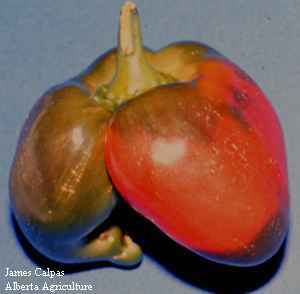
Figure 47. Malformed fruit caused by lygus bug feeding injury when the fruit was in the very young "bud" stage
Earwigs
The European earwig (Forficula auricularia) can be quite common in greenhouses. These insects are brown in color and about 10 - 15 millimeters long. They are easily identified by the presence of distinctive "cerci", or appendages located at the back end of the insect. In the male earwigs, the cerci resemble pincers, the cerci are almost straight on female earwigs. Earwigs are often found under the sawdust bags or rockwool slabs or hiding in other dark, moist, protected areas. Earwigs are nocturnal and feed on a variety of things, including plants and other insects.
Earwigs have occasionally become a problem in greenhouse sweet pepper crops by moving into the crop canopy and damaging pepper fruit located up to one meter off the floor. The earwigs burrow into the fruit at the calyx, the damage resembling that caused by loopers. Cutting the fruit open often reveals a mature earwig. The holes in the fruit and the associated frass renders the fruit unfit for market.
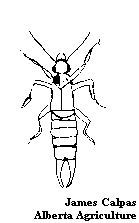
Figure 48. Earwig.
Control of these insects is obtained by trapping them when they are still on the greenhouse floor, before they move into the canopy. Commercial traps and baits are available. |
|